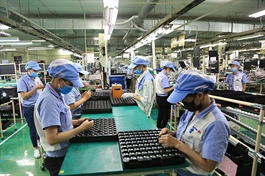National strategy on green growth to help Vietnam post-pandemic recovery
National strategy on green growth to help Vietnam post-pandemic recovery
The strategy is significant given the fact that Vietnam has long been seen as one of the most vulnerable countries to climate change, natural disasters, and diseases.
Vietnam’s national strategy on green growth would play a key role in the ongoing efforts to restructure the economy and revise the growth model.

Minister of Planning and Investment Nguyen Chi Dung at the launch. Source: MPI |
“This is the key solution for Vietnam to ensure sustainable development and thrive during the post-pandemic period.”
Minister of Planning and Investment (MPI) Nguyen Chi Dung stressed the view at the conference held today [October 29] to launch the national green growth strategy for the 2021-2030 period, with a vision to 2050, previously signed off by Prime Minister Pham Minh Chinh in early October.
In the long run, Dung expected the strategy to lay the foundation for Vietnam to keep a low level of carbon emission, eventually reaching the goal of a neutral-carbon society and contributing to combating global warming.
According to Dung, the fact that Prime Minister Pham Minh Chinh approved the national strategy on green growth before attending the 26th UN Climate Change Conference of the Parties (COP26) in Glasgow, the UK, showed Vietnam’s strong commitment to reducing greenhouse gas emissions via specific actions.
The strategy put forth the goal of slashing greenhouse emissions by at least 15% in 2030 against the level recorded in 2014; and 30% by 2050.
Other key targets include collecting and treating 95% of urban solid waste by 2030, and 50% of wastewater.
“Such commitments are especially important, given the fact that Vietnam has long been seen as one of the most vulnerable countries to climate change, natural disasters, and diseases,” Dung stated.
Le Viet Anh, head of the MPI’s Department of Science, Education, Natural Resources and Environment, said the development priorities for key economic sectors would be to minimize energy losses during production or transportation for greater efficiency.
“Vietnam aims to ensure energy security and shift towards the use of renewables,” he added, referring to efforts to raise the proportion of renewables out of the total power mix to 15-20%.
Anh expected the emergence of green economic sectors would gradually reduce carbon emissions.
In order to realize these targets, Anh called for ministries and Government agencies to incorporate green growth solutions into new policies to accelerate economic restructuring for resources optimization, especially in infrastructure development.
“The Government would provide new incentives to mobilize resources for green economic development,” Anh added, noting the private sector could play a key role in this regard via the public-private partnership (PPP) financing mechanism in green projects.
Deputy Director-General of the Department of Science, Technology, and Environment under the Ministry of Agriculture and Rural Development (MARD) Nguyen Giang Thu said the ministry has issued the sector’s development strategy that consists of green growth targets in agricultural production.
“The MARD would cooperate with the MPI in building plans to realize green the growth targets,” she added.
The long-term goal is for Vietnam to have a modern and organic agricultural sector, Thu said, which not only helps ensure social welfare and sustainable development but also speeds up the urbanization towards smart and sustainable cities with a high level of climate resilience.
|
The strategy places a strong focus on raising people’s living standards and their resilience against climate change, ensuring fairness in the distribution of benefits from the economic development process. By 2030, the human development index (HDI) would be over 0.75 from the current 0.74, taking Vietnam to the group of countries with high human development level according to the metrics of the UN Development Program (UNDP); 100% of provinces/cities would have air quality control program, and at least 70% of the population would use clean water under standards of the Ministry of Health. |























